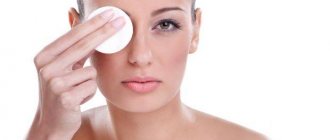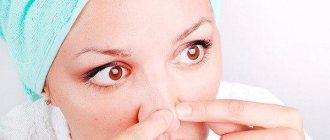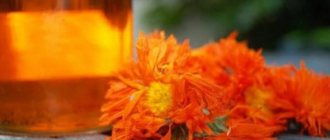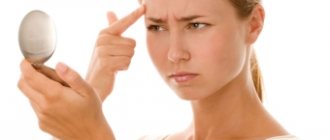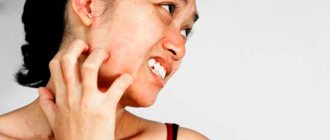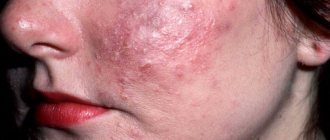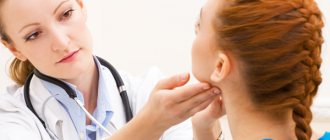#10 reasons for the problem
The reason for the appearance of red pimples on a woman’s face may be the use of low-quality decorative cosmetics.
However, most often the skin is affected by several factors at once that cause the appearance of rashes.
The main causes of acne on the face and back include:
- Lack or improper skin care. Very often, pimples appear in the same place on the face, which does not receive sufficient care. The correct selection of cosmetics and daily care can cope with this problem.
- Improper functioning of the sebaceous glands is the cause of acne.
- Digestive problems are one of the most common causes of rashes. Chronic gastritis, peptic ulcer, malabsorption of foods are considered the main causes of acne on the skin of the face and body.
- Sudden changes in the concentration of hormones in the body. So, in women, the cause of rashes can be childbirth, pregnancy, and even the beginning of the menstrual cycle.
- Diseases of the endocrine glands - very often rashes in adults appear against the background of hypothyroidism or diabetes.
- Allergic rashes occur in both adolescents and older adults. Very often they are not diagnosed and are simply covered with creams, which leads to a deterioration in the condition of the skin.
- Infectious diseases often manifest themselves as rashes on the skin. One of the signs of an infectious pathology is the localization of acne not only on the face, but also spread to other parts of the body.
- Pustular pyoderma or staphylococcal acne on the face often appears in adolescence and does not go away even with the use of good cosmetics. In this case, there is a bacterial infection of the skin that requires treatment with antibiotics.
- Another cause of facial rashes is stress. Acne can appear both after suffering a strong stress reaction, and during daily exposure to an excessive amount of strong emotions. It is impossible to eliminate this cause of acne. However, you can adjust the body's response to a stress factor. To do this, you will need the help of a psychotherapist.
- There is an opinion that during or after ARVI, acne appears due to the disease, but it is wrong. Damage to the upper respiratory tract by viral agents is manifested by cough, runny nose, and fever. Rashes on the face appear regardless of the disease.
In men, the causes of rashes are almost the same as in women.
To determine the cause of acne and select the correct treatment method, you need to consult a cosmetologist or dermatologist in a good clinic.
After an examination and several tests, the doctor will be able to identify the cause of the rash and select an individual treatment method.
What do the doctor's say?
Although evidence-based medicine refutes the connection between the localization of acne and diseases, many specialists pay attention to skin manifestations when diagnosing. Endocrinologists especially carefully analyze the condition of the dermis and changes in it. A decrease in rashes is a good sign of stabilization of hormonal levels and the current treatment regimen.
Often, dermatologists, whose task is to solve skin problems, send patients for additional examinations to other doctors. Long-term practice shows that without eliminating internal failures and treating chronic diseases, curing acne can be extremely problematic.
About classifications (7 types)
The appearance of the rashes very often helps to understand the reasons for their appearance and treatment tactics, so it is very important to know the types of acne on the face and correlate them with specific rashes.
The following types of acne can be distinguished:
- Tubercle - rises above the surface of the skin, does not have a cavity. Squeezing it out can lead to the formation of deep scars.
- A furuncle is a purulent pimple on the face, the formation of which is caused by the penetration of bacterial flora into the hair follicle, and treatment consists of the use of antibacterial drugs.
- Carbuncle is a purulent inflammation of several adjacent hair follicles.
- A papule is a small nodule inside the skin that goes away on its own without leaving a trace.
- A vesicle is a bubble filled with contents.
- Roseola is a fuzzy spot of a reddish-pinkish color that does not rise above the surface of the skin. Most often, allergic acne appears on the face.
- Hemorrhagic rash - sharp elements that appear as a result of hemorrhages. It is often a manifestation of serious infectious diseases.
White pimples on the face that are not squeezed out can either be immature elements of the rash, or be a manifestation of diseases of the digestive system. When they appear, it is necessary to carry out diagnostic measures especially carefully.
In addition to appearance, you need to pay attention to possible additional symptoms - redness of the skin between rashes, itching, burning sensation.
Photos and names of each element of the rash can be easily found using search engines. But it can be quite difficult for an ordinary person to distinguish them in everyday life. It is best to show acne to a cosmetologist-dermatologist.
Causes of pustules
Multiple appearance of purulent elements indicates pathological infectious processes. The main reason for the formation of pustules on the hands is lack of hygiene, so in order to prevent the disease, it is important to keep your hands clean. The following reasons leading to the formation of pustular rashes may be:
- spread of a bacterial infection on the dermis, leading to an inflammatory process;
- decreased immunity;
- any injury or irritation of the epidermis (abrasion, scratching, burn);
- consequences of skin pathologies (scabies, boils, psoriasis).
Superficial pustules (impetigo) are formed due to exposure to pyogenic microbes. Formations caused by staphylococcus are follicular, that is, the sebaceous glands and hair follicles are involved in the process of inflammation. Non-follicular pustules, formed as a result of streptococci penetrating the skin, look like blisters.
The shape of purulent formations can be spherical, cone-shaped and flat
On a note. Pustulosis is often observed in weakened children. Elements appear on the head or in the area around microtrauma. In a short period, a single formation can surround itself with similar rashes.
Zoning theory (zones where acne appears)
According to the ancient traditions of oriental medicine, it is believed that the human face is divided into certain zones. Each of them is a projection that displays the work of internal organs.
The appearance of redness or rashes in a certain area of the face was a reason to conduct an examination of the system in the projection of which these formations appeared.
In the photo on the Internet you can find out what exactly acne on the face means, namely, to understand which organs are responsible for certain areas of the face.
Traditionally, there are 5 zones of the face:
- The forehead is a projection of the small intestine and bladder.
- The temporal zone is responsible for the functioning of the gallbladder.
- The chin is the pelvic organs.
- The nose indicates the functioning of the liver, as well as the pancreas.
- Cheeks and cheekbones - the appearance of rashes in this area may indicate problems with the heart, lungs, large intestine, and stomach.
The area under the eyes is believed to indicate kidney function. However, rashes in this area appear extremely rarely. With changes in the functioning of the renal system, morning puffiness under the eyes often appears.
Modern medicine and cosmetology are quite skeptical about the theory of zoning. Leading cosmetologists, when acne appears, recommend starting with an examination of the gastrointestinal tract and choosing the right cosmetics for facial care.
Types of rashes
The following main types are distinguished:
Comedo. Appears in cases where the pore is clogged with fat. Sometimes there is a black dot on the surface. If the comedone is closed, then such a point is absent; instead, a bulge with a white top is formed.
Papule. Similar to comedones, but in a more inflamed and advanced form. It is a sign of acne.
Knot. They form deep in the skin, are very painful and most often form a focus of several pimples. If the tops of these formations are filled with fat, they acquire a grayish-yellow color, while the pimple itself is red-blue. If such a pimple breaks out on its own, then no traces remain afterwards.
Lightning acne. These rashes require urgent medical intervention, otherwise they are fraught with the formation of scars.
Selection of adequate therapy
It’s better not to self-medicate, but to go to a dermatologist, because today there are many modern techniques that can really help you get rid of a pimply face.
The most popular procedures to combat the problem are:
- Chemical peeling. The skin is treated with an acid of a certain concentration, which removes sebaceous plugs and accelerates regeneration.
- Laser resurfacing. It resembles peeling, but the doctor works with a laser, not acid.
- Ozone therapy. In this case, acne is eliminated using ozone. It disinfects, removes germs, bacteria, and fights the inflammatory process.
- Ultrasonic cleaning. Ultrasound is applied to the face, which effectively cleanses the skin.
- Mechanical cleaning. You cannot squeeze out pimples on your own, but in a salon setting, a doctor is able to clean the pores correctly and sterilely, using special devices (for example, a Uno spoon).
You need to understand that you need to fight acne comprehensively. This requires competent home care, special products and cosmetic procedures.
Dermatologist Robert Weiss
In addition to the help of a professional, the basic principles of treating rashes on the face are highlighted.
- Wash your face daily in the morning and evening (after removing all makeup and creams).
- Use of professional medicinal cosmetics - lotion, tonic, cream, serum, scrub. If you want to get rid of acne, you will have to forget about standard cheap facial care products. Only special products can get rid of problem skin.
- Use of high-quality decorative cosmetics. The appearance of acne and its treatment in women does not exclude the use of makeup. However, in order not to negate all the efforts of therapy and to prevent the appearance of new rashes, you should use only high-quality hypoallergenic cosmetics .
- Concomitant treatment of somatic pathologies - gastritis, colitis, correction of thyroid hormone levels.
- Use local antibiotics to treat pustular skin lesions as prescribed by a doctor.
In the first weeks of treatment, the number of rashes may increase. This is a normal reaction of the skin, which means that the elements of the rash that were just forming begin to quickly go through all stages of their development. Over the next 3 weeks, the number of pimples will decrease, and new ones will not appear.
Dermatologist Margaret Weiss
Separately, you need to think about how to get rid of white subcutaneous pimples on the face. Most often, they are caused by hormonal imbalance and diseases of the gastrointestinal tract. In the treatment of such elements of the rash, special attention is paid to the condition of the body.
The Internet is replete with photos of teenagers - both girls and boys - who, with the help of a miraculous remedy, got rid of acne in 1-2 procedures.
You should not trust these pictures - in fact, in 1-2 procedures you can only dry out the rashes. Full treatment of the rash takes several weeks.
Application of ointments
After an examination, a dermatologist may prescribe the use of a certain ointment that is aimed at combating acne.
Retinoic ointment, Defferin, Klenzin, Klindovit ointments, and Curiosin gel are considered the most effective. But there are many other good remedies.
Considering the cause of acne, the patient may be prescribed antibiotics, hormonal drugs, and retinoids.
Dermatologist Karin Grossman
Prevention
You can avoid the appearance of pustules if:
- strictly observe the rules of personal hygiene,
- regularly use skin cleansers,
- get rid of any infectious disease in a timely manner,
- constantly strengthen the immune system,
- Healthy food,
- to refuse from bad habits,
- maintain an active lifestyle.
Any damage to the skin must be treated with an antiseptic, and wounds, abrasions and scratches must be taken care of until they are completely healed.
Professional advice regarding products
To get rid of acne, you need to know which products actually work.
Most of the ingredients known to fight acne-causing bacteria and clear skin are available in the aisles of your local pharmacy.
Dermatologist Hadley King (New York)
Below are the remedies recommended by the doctor.
Cleanser
There's nothing better in your acne-fighting arsenal than salicylic acid.
This is a great pore cleanser because it exfoliates the surface of the skin and penetrates into the pores to remove oil. It is even useful as an acne preventative.
Dermatologist Hadley King (New York)
While there's no shortage of salicylic cleansers on the market, Dr. recommends Neutrogena Pink Grapefruit Oil-Free Acne Wash ($7.99).
Ideal for people with oily or acne-prone skin, it helps prevent the formation of comedonal pimples (blackheads and whiteheads).
For those struggling with more inflammatory acne, your doctor suggests using a cleanser with benzoyl peroxide.
This could be, for example, PanOxyl Creamy Acne Wash (9.48 cu), which contains 4% benzoyl peroxide.
Benzoyl peroxide has mild comedolytic properties and an antibacterial effect, which makes it an excellent choice for both comedones and inflamed acne.
Dermatologist Hadley King (New York)
Spot treatment
For spot treatment of acne, microbenzoyl peroxide is beneficial in combination with soothing ingredients such as chamomile, ginger, and seaweed, which help reduce inflammation in active acne.
Such a product is, for example, AcneFree Terminator 10 Acne Spot Treatment ($7.79).
Moisturizing cream
There is a misconception that keeping your skin moisturized can clog your pores and actually cause acne.
But it's actually important to keep your skin hydrated: when it's dry, it starts to produce more oil, which can lead to further breakouts.
With this in mind, it is recommended to use a non-comedogenic moisturizer. Cerave cream has proven itself well (15.49 cu).
It contains hyaluronic acid, which is a powerful skin moisturizer, as well as ceramides, which support the skin barrier, and petrolatum, which locks in that moisture.
Retinol
Retinol is a proven ingredient for treating and preventing acne.
It is recommended to use adaptolene, a third generation retinoid with proven efficacy and tolerability for the treatment of acne, as well as anti-inflammatory effects.
Dermatologist Hadley King (New York)
La Roche Posay Adapalene Gel (29.99 USD) is a product with such a component. It is recommended to use it every evening for maximum benefits.
Sunscreen
Sunscreen is an important product. Sun protection is crucial in any skin care routine, but for those struggling with acne, it's important to look for a product with antibacterial ingredients.
A good product is CeraVe Hydrating Face Sunscreen SPF 50 ($13.89). It has a 100% mineral formulation that contains hyaluronic acid to hydrate, as well as ceramides to support the skin barrier and niacinamide to improve tone and texture.
Powder formulations such as Brush On Block Mineral Sunscreen ($32) can also be beneficial for oily, acne-prone skin. It absorbs excess oil so it can do double duty as a powder, actually making your makeup last longer and providing sun protection.
Dermatologist Hadley King (New York)
Expert advice
Below are tips from dermatologist Davin Lim, who has 17 years of experience in the field of dermatology and cosmetology:
- Use cleansers (such as Neutrogena) with 2% salicylic acid. This is a beta hydroxy acid. It has anti-inflammatory, exfoliating properties. This remedy is great for acne.
- Benzoyl peroxide may also improve inflammatory acne. Start with a 5% concentration, you can increase it later. If you have sensitive skin, start with 2.5%. Do not wash off the product immediately; it should remain on the skin for a minute. Benzac AC is an affordable product.
- Vitamin A creams can also help clear up acne.
- Chemical peels are also effective in treating most forms of acne. Salicylic acid is often prescribed by dermatologists in concentrations ranging from 10 to 30%. The procedure must be performed by a doctor. Peels with glycolic acid or other AHAs may also help.
- Diet is extremely important when treating acne.
- Women should pay attention to the cosmetics they use. Don't forget to remove your makeup. Mineral cosmetics are best because they do not contain talc or parabens, and most importantly, they do not clog pores. You can also have makeup-free days. Allowing your skin to breathe at least 2-3 days a week will also reduce acne.
- Light therapy is also used by dermatologists. Blue and red light work by killing bacteria in acne. This form of therapy is called "low level laser therapy." LLET is best used as an adjunctive therapy. Kleresca is another form of acne treatment using photodynamic therapy.
- Contact a dermatologist. The specialist will select the appropriate therapy. In most cases, acne can be removed in a short period of time. Doctors often prescribe anti-inflammatory tablets and creams with vitamin A.
The ideal treatment will depend on your lifestyle as well as your clinical presentation.
Acne and pimples on the skin from a psychosomatic point of view
Psychosomatics is the science of the relationship between soul and body. Adherents of the doctrine believe that all health problems are associated with internal fears, nerves, and experiences. If you eliminate them, the acne goes away on its own:
- Body Says Love Yourself! She is sure that a pimple is a tiny tumor located on the surface of the skin. If red or white pimples periodically appear on the skin and then disappear, this indicates intolerance towards others. Also, behind acne there may be a constant fear of “losing face” in public, “misfiring” and making a mistake.
- Louise Hay, author of Heal Yourself . A specialist in the field of psychosomatics is sure: pimples and blackheads appear as a reflection of negative attitudes (lack of self-love, constant imbalance). To cope with rashes, it is necessary to replace negative attitudes with harmonizing thoughts: “I will succeed!”, “I love myself, I accept myself!”.
- Dr. Luule Viilma, author of the manual “Psychological Causes of Diseases” . The specialist is confident that any pustular processes (acne or pimples) indicate humiliated anger. Let it go and you will feel much better.
- Bodo Baginski and Sharamon Shalila, authors of the manual “Reiki, the universal energy of life . If you have blackheads, red or white pimples, this indicates barriers to communication with others (perhaps everything happens subconsciously, but you do not suspect it).
- Dr. Valery V. Sinelnikov, author of the acclaimed manual “Love your illness . The specialist is confident that skin diseases do not exist at all. Attempts to “cover up” the problem with gels, lotions and other compounds only aggravate the problem. Acne and pimples are old and hidden dirt that “seeks to the top” (as a rule, this can be suppressed emotions, anxiety, fear, a feeling of constant danger, intolerance towards others, disgust, guilt, anger, resentment and others). To get rid of the disease, you need to understand the cause and restore emotional balance.
- Sergey Konovalov, author of the book “Energy-information medicine according to Konovalov. Healing emotions . The specialist is sure that pimples, blackheads and acne are a reaction to fear and anxiety. To get rid of rashes, you need to change your attitude towards life, become calmer, and conduct meditation sessions.
- Dr. Oleg G. Torsunov, author of the textbook “The Connection of Diseases with Character . The specialist builds his teaching on the basis of the Vedas. During a long study, he realized that pustular rashes, pimples and acne can provoke negative emotions: aimlessness, sloppiness, overwork, greed, uncleanliness, stress. Each of them has its own characteristics of manifestation.
But psychosomatics is not the only teaching that seeks to understand the connection between “external and internal.” To help yourself, use simple rules (but do not forget to consult a dermatologist):
- Determine your goals and objectives in life, find your purpose, set your priorities correctly (in your personal life and in your public life!).
- Learn to forgive yourself, your failures and mistakes. Just accept the fact that everyone (including you) can make the wrong decision.
- Allow yourself good and regular rest. This could be a trip out of town, a hike in nature, yoga, morning meditation, reading a book, a massage in a spa. The main thing is that you rest both body and soul.
- Treat pimples, blackheads and boils only as a temporary phenomenon. They should not control your life, be an obstacle to new acquaintances, an active life, or the fulfillment of desires.
Important rules (4 useful tips)
If subcutaneous pimples appear on the face, enlarged pores are present, you must try to find the cause of their occurrence and eliminate it.
However, their treatment, both in adolescents and adults, can take quite a long period of time.
There are several simple rules that will make it easier to survive this period of time and not worry about rashes:
- Wash your face every day (morning and evening). Taking care of your facial skin in this way not only allows you to accustom yourself to the necessary ritual, but also improves tone and reduces redness.
- Minimize the use of decorative cosmetics. Of course, leaving the house without makeup with red rashes causes internal discomfort in a person. Especially when it comes to the need to work with people. There is no need to give up makeup when treating acne. It is important to select cosmetics that do not close pores and do not cause an allergic reaction. They should be applied to the skin only after all medicinal cosmetics have been absorbed. In this case, you can get a practically even tone and not interrupt the treatment of acne on your face.
- Use little tricks. Girls are terribly worried when rashes appear on their faces before important events. A professional makeup artist will help you disguise acne before such important events as a wedding, a reunion or a business trip. Correctly applied makeup will make the skin smooth and even, and the girl happy. When there is a need to preserve memories in the form of photos, you can seek help from a professional who will tell you how to remove acne on your face in Photoshop or do it yourself. Special programs for Photoshop allow you to process photographs of people even with severe manifestations of acne.
In the photo on the Internet you can see what will happen visually if you squeeze pimples on the face, but redness and an increase in the size of the rash is not the worst complication.
When squeezing a pimple, very often, an infection is introduced into the skin, which quickly multiplies and leads to the formation of pustules. Instead of 1-3 pimples, a person can get 20-30 purulent rash elements.
Dermatologist Corey Frucht
The face has extremely thin skin and a dense network of arteries and veins. If you squeeze out a large purulent pimple, there is a risk of pus entering the brain through the system of blood vessels and developing abscesses. This is a life-threatening condition.
What is a pustule and what does it look like?
Vesicles are spherical bubbles that form in the skin. The elements exhibit white or grayish purulent contents. If the disease is accompanied by infection, the substance becomes greenish or yellowish.
The development of inflammatory reactions leads to damage to nearby vessels. Blood is added to the purulent masses inside the pustule. The blister takes on a reddish tint and may itch.
The diameter of the elements ranges from 1 to 10 millimeters. At the top of the spherical attribute there is a purulent head, which distinguishes a pustule from a papule.
Expert opinion
- Surgeon
- Cosmetologist
Elsa Borodina
plastic surgeon
When acne appears, pay attention to your diet. For example, a diet that excludes carbohydrates (especially sugar, sweet drinks, chocolate, baked goods) is suitable. And, conversely, it is worth including a large amount of vegetables and dairy products in your diet. Proper nutrition will help cope with much of the problem.
Irina Dorofeeva
practicing cosmetologist
If you have a pimply face and home remedies don't help, you should seek professional help. Ozone therapy is suitable for this, which involves exposing the skin to ozone, which ultimately destroys microbes, reduces the inflammatory process, swelling, and acne. In addition, ultrasonic cleaning or peeling with chemical acids will be beneficial. The appearance of acne on the face is a rather unpleasant cosmetic problem that requires long-term treatment. Only a thorough diagnosis will allow you to find the cause of the rashes and determine what to do with them in each specific case.
Phlyctena as a type of pustule: causes of formation and localization
Phlyctena is a flabby element of the rash on the skin outside the follicle. In the field of dermatology, a formation is considered to be a flattened formation on the epidermis or mucosa, filled with a cloudy infiltrate. The acute manifestation is similar to streptoderma at the initial stage.
The nodule forms in the conjunctiva, in the upper layer of the cornea of the eye. The attribute consists of lymphoid, epithelioid cells. The presence of this type of pustule indicates an allergic reaction to tuberculosis. To determine effective treatment for the disease, make an appointment with an ophthalmologist.
Phlyctena is formed from erythematous spots and can appear on damaged skin. The bubble grows within 5-7 days, the thin plug is opened. The infiltrate dries out and takes the form of a serous-purulent layered crust, which becomes loose. The layer of skin where the pustule is located may have a yellowish tint.
Need advice from an experienced doctor?
Get a doctor's consultation online. Ask your question right now.
Ask a free question
When the crust falls off, erosion is exposed. There are no scars left after the disease is removed.
Often the formation is observed on the arms, face, and torso. A phlyctena may occur under the cast during a fracture due to increased sweating of the skin. Blood circulation in the immobilized limb is reduced, and compression of the soft tissue provokes swelling and rash.
Phlyctena during a fracture is a complication of the disease, which is difficult to get rid of due to its location under the bandage. If a pustule appears under a cast, it can be removed, antiseptic precautions taken, and the skin treated with disinfectants.
The form of the disease may be accompanied by polyadenitis, low-grade fever (fever), and changes in blood composition.
